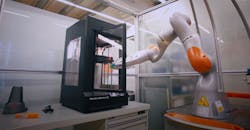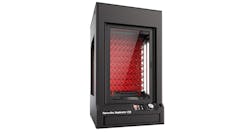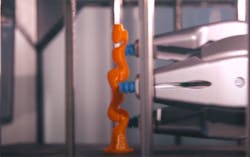KUKA and MakerBot Team Up Supercharges Manufacturing Potential
Being 2018 and all, we know you don't need to be talked into using 3D printers to speed up your product design process. It's called rapid prototyping for a reason. A recent video released by MakerBot does offer some new insights into the specifics of just how important 3D printing is to the future of innovation. Watch how robotics maker KUKA leverages the MakerBot Replicator Z18 below:
An initial takeaway here is that MakerBot’s Z18 is a workhorse. It ran 7,000 hours in 2016, or 80% of the entire year, and had a 92% success rate. This 4-year-old 3D printers starts at $6,500, so that’s a pretty impressive.
It’s how the machine is being used that should appeal universally to all product engineers and design teams.
“As soon as we give models and data to our suppliers that make metal components, we start 3D printing robot parts,” explains Sören Papsdorf, KUKA’s head of manufacturing engineering. “Because we can do that development stage with one-to-one scale printed components, by the time we have actual aluminum or metal parts, we have already made a number of revisions.”
While this may be a quite obvious application and best way to stay productive while waiting on a machine shop to make and send back your metal part for further testing, that just means you are ahead of the curve. Because, according to Sculpteo’s State of 3D Printing survey, only 28% of the industry professionals considered accelerating product development the top priority, although 57% of all the applications were in proof of concept and prototyping.
You’d think any manufacturer’s top priority was to create the best product the fastest and get it to market before anyone else. If you’re not doing it, rest assured the competition will be.
And KUKA double dips with the tech by not only prototyping, but by making actual end-use pieces of its custom end effectors to minimize the weight and number of parts.
It’s studies like this that reinforce how vital a 3D printing strategy is for any manufacturer. Sure, it’s easy for the world’s largest robotics manufacturer to invest in this tech and take the time to develop a program. But it’s not like they used a $100,000 machine here, it was $6,500. That’s chump change even an ETSY boutique would drop for the ROI.
And if you don’t have a 3DP plan in place, you might be left behind. Gartner predicts that “by 2021, 40% of manufacturing enterprises will establish 3D printing centers of excellence.”
That means it won’t just be the Fortune 500 group trying to squeeze every bit of innovation out of those plastic extruders. Every company big and small will be trying to get a competitive advantage, figuring out the best way to beat you to market.
What this case study ultimately proves is that you have a relatively inexpensive tool at your disposal that allows you to develop parts faster, and even make some that weren’t previously possible. And if you aren’t using it, your business is not meeting its potential.
About the Author
John Hitch
Editor, Fleet Maintenance
John Hitch, based out of Cleveland, Ohio, is the editor of Fleet Maintenance, a B2B magazine that addresses the service needs for all commercial vehicle makes and models (Classes 1-8), ranging from shop management strategies to the latest tools to enhance uptime.
He previously wrote about equipment and fleet operations and management for FleetOwner, and prior to that, manufacturing and advanced technology for IndustryWeek and New Equipment Digest. He is an award-winning journalist and former sonar technician aboard a nuclear-powered submarine where he served honorably aboard the fast-attack submarine USS Oklahoma City (SSN-723).



